The British Museum in London is, in addition to being one of the oldest museums in the world, one of the largest and most famous collections of antiquities in existence.
 |
| British Museum London |
Currently, the British Museum receives more than 5 million annual visitors, which makes it the third most visited museum in the world, behind the Louvre in Paris and the Metropolitan Museum in New York.
The Collection
The museum was created in 1753 and was permanently opened to the public on January 15, 1759. The origins of the British Museum are linked to the physicist and collector Hans Sloane, who wanted his collection of more than 80,000 items to endure after his death. The objects in the collection included more than 40,000 books and antiquities from Greece, Rome, Egypt, the Middle East and America.
 |
| British Museum London |
The first location of the British Museum was the Montagu House, a 16th century mansion that began to get small due to the rapid growth of the collections, both due to the purchases made by the museum, as well as the different donations.
In 1782 the collection of pieces of Greek and Roman origin increased considerably and, after this, in 1801 the museum acquired a great quantity of Egyptian antiquities, among which is included the impressive Rosetta Stone (thanks to which they have been able to translate the Egyptian hieroglyphs). In 1823 King George IV donated his father's library entirely, so the museum building began to get too small.
 |
| British Museum London |
In 1852 the construction of the new museum building was completed, located in its previous location, which is the one that remains to this day.
In 1887, due to lack of space, the collection of natural objects was moved to the Museum of Natural History, and in 1973 the British Library became independent from the museum.
 |
| British Museum London |
History
Established in 1753 by scientist Hans Sloane, it was opened to the public in 1759, with a collection consisting mostly of books, manuscripts, natural specimens, and some antiques such as coins, medals, drawings, and watches.